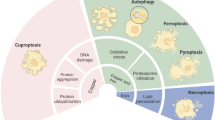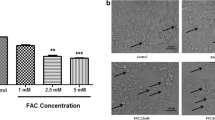Abstract
In order to elucidate the mechanisms involved in apoptosis induction by iron deprivation, we compared cells sensitive (38C13) and resistant (EL4) to apoptosis induced by iron deprivation. Iron deprivation was achieved by incubation in a defined iron-free medium. We detected the activation of caspase-3 as well as the activation of caspase-9 in sensitive cells but not in resistant cells under iron deprivation. Iron deprivation led to the release of cytochrome c from mitochondria into the cytosol only in sensitive cells but it did not affect the cytosolic localization of Apaf-1 in both sensitive and resistant cells. The mitochondrial membrane potential (Δψm) was dissipated within 24 h in sensitive cells due to iron deprivation. The antiapoptotic Bcl-2 protein was found to be associated with mitochondria in both sensitive and resistant cells and the association did not change under iron deprivation. On the other hand, under iron deprivation we detected translocation of the proapoptotic Bax protein from the cytosol to mitochondria in sensitive cells but not in resistant cells. Taken together, we suggest that iron deprivation induces apoptosis via mitochondrial changes concerning proapoptotic Bax translocation to mitochondria, collapse of the mitochondrial membrane potential, release of cytochrome c from mitochondria, and activation of caspase-9 and caspase-3.
Similar content being viewed by others
References
Evan GI, Brown L, Whyte M, Harrington E. Apoptosis and the cell cycle. Curr Opin Cell Biol 1995; 7: 825–834
Leist M, Nicotera P. The shape of cell death. Biochem Biophys Res Commun 1997; 236: 1–9
Raff M. Cell suicide for beginners. Nature 1998; 396: 119–122
Earnshaw WC, Martins LM, Kaufmann SH. Mammalian caspases: structure, activation, substrates, and functions during apoptosis. Annu Rev Biochem 1999; 68: 383–424
Kroemer G. Mitochondrial control of apoptosis: an introduction. Biochem Biophys Res Commun 2003; 304: 433–435
Rodriguez J, Lazebnik Y. Caspase-9 and APAF-1 form an active holoenzyme. Genes Dev 1999; 13: 3179–3184
Le NT, Richardson DR. The role of iron in cell cycle progression and the proliferation of neoplastic cells. Biochim Biophys Acta 2002; 1603: 31–46
Thelander L, Graslund A, Thelander M. Continual presence of oxygen and iron required for mammalian ribonucleotide reduction: possible regulation mechanism. Biochem Biophys Res Commun 1983; 110: 859–865
Lill R, Diekert K, Kaut A, et al. The essential role of mitochondria in the biogenesis of cellular iron- sulfur proteins. Biol Chem 1999; 380: 1157–1166
Ragba N, Loyer P, Gilot D, et al. Antiproliferative and apoptotic effect of O-Trensox, a new synthetic iron chelator, on differentiated human hepatoma cell lines, Carcinogenesis 2000; 21: 943–951
Simonart T, Boelaert JR, Mosselmans R, et al. Antiproliferative and apoptotic effect of iron chelators on human cervical carcinoma cells. Gynecol Oncol 2002; 85: 95–102
Shterman N, Kupfer B, Moroy C. Comparison of transferrin receptors, iron content and isoferritin profile in normal and malignant human breast cell lines. Pathobiology 1991; 59: 19–25
Taetle R, Honeysett JM, Bergeron R. Combination iron depletion therapy. J Natl Cancer Inst 1989; 81: 1229–1235
White S, Taetle R, Seligman PA, Rutheford M, Trowbridge IS. Combinations of anti-transferrin receptor monoclonal antibodies inhibit human tumor cell growth in vitro and in vivo: evidence for synergistic antiproliferative effects. Cancer Res 1990; 50: 6295–6301
Seligman PA, Crawford ED. Treatment of advanced transitional cell carcinoma of the bladder with continuous-infusion gallium nitrate. J Natl Cancer Inst 1991; 83: 1582–1584
Kemp JD, Thorson JA, Stewart BC, Naumann PW. Inhibition of hematopoietic tumor growth by combined treatment with deferoxamine and an IgG monoclonal antibody against the transferring receptor: Evidence for threshold model of iron deprivation toxicity. Cancer Res 1992; 52: 4144–4148
Donfrancesco A, Deb G, De Sio L, Cozza R, Castellano A. Role of deferoxamine in tumor therapy. Acta Haematol 1996; 95: 66–69
Kovar J, Naumann PW, Stewart BC, Kemp JD. Differing sensitivity of non-hematopoietic human tumors to synergistic anti-transferrin receptor monoclonal antibodies and deferoxamine in vitro. Pathobiology 1995; 63: 65–70
Fuhuchi K, Tomoyashu S, Tsuruoka N, Gomi K. Iron deprivation-induced apoptosis in HL-60 cells. FEBS Lett 1994; 350: 139–142
Hileti D, Panayiotidis P, Hoffbrand AV. Iron chelators induce apoptosis in proliferating cells. Br J Haematol 1995; 89: 181–187
Haq RU, Wereley JP, Chitambar CR. Induction of apoptosis by iron deprivation in human leukemic CCRF-CEM cells. Exp. Hematol. 1995; 23: 428–432
Kovar J, Stunz LL, Stewart BC, Kriegerbeckova K, Ashman RF, Kemp JD. Direct evidence that iron deprivation induces apoptosis in murine lymphoma 38C13. Pathobiology 1997; 65: 61–68
Rakba N, Nguyen-Van-Duong MK, Nicolas L, et al. Cytoprotection and iron mobilization in rat hepatocyte cultures by a new synthetic dihydroxamate chelator. Toxicol Lett 1999; 110: 19–27
Darnell G, Richardson DR. The potential of iron chelators of the pyridoxal isonicotinoyl hydrazone class as effective antiproliferative agents III: The effect of the ligands on molecular targets involved in proliferation. Blood 1999; 94: 781–792
Ido Y, Muto N, Inada A, et al. Induction of apoptosis by hinokitiol, a potent iron chelator, in teratocarcinoma F9 cells is mediated through the activation of caspase-3. Cell Prolif 1999; 32: 63–73
Simonart T, Degraef C, Andrei G, et al. Iron chelators inhibit the growth and induce the apoptosis of Kaposi’s sarcoma cells and of their putative endothelial precursors. J Invest Dermatol 2000; 115: 893–900
Weiner RE, Avis I, Neumann RD, Mulshine JL. Transferrin dependence of Ga(NO3)3 inhibition of growth in human-derived small cell lung cancer cells. J Cell Biochem Supl 1996; 24: 276–287
Hsieh-Ma ST, Reeder J, Ring DB. In vitro tumor growth inhibition by bispecific antibodies to human transferrin receptor and tumor-associated antigens is augmented by the iron chelator deferoxamine. Clin Immunol Immunopathol 1996; 80: 185–193
Kemp JD, Cardillo T, Stewart BC, et al. Inhibition of lymphoma growth in vivo by combined treatment with hydroxyethyl starch deferoxamine conjugate and IgG monoclonal antibodies against the transferrin receptor. Cancer Res 1995; 55: 3817–3824
Kemp JD. Iron deprivation and cancer: a view beginning with studies of monoclonal antibodies against the transferrin receptor. Histol Histopathol 1997; 12: 291–296
Kovar J, Valenta T, Stybrova H. Differing sensitivity of tumor cells to apoptosis induced by iron deprivation in vitro. In Vitro Cell Dev Biol Anim 2001; 37: 450–458
Truksa J, Kovar J, Valenta T, Ehrlichova M, Polak J, Naumann PW. Iron deprivation induces apoptosis independently of p53 in human and murine tumour cells. Cell Prolif 2003; 36: 199–213
Kovar J, Franek F. Growth-stimulating effect of transferrin on a hybridoma cell line: relation to transferrin iron-transporting function. Exp Cell Res 1989; 182: 358–369
Chen TR. In situ detection of mycoplasma contamination in cell cultures by fluorescent Hoechst 33258 stain. Exp Cell Res 1977; 104: 255–262
Kovar J. Growth-stimulating effect of ferric citrate on hybridoma cells: Characterization relation to transferrin function. Hybridoma 1988; 7: 255–263
Smith PK, Krohn RI, Hermanson GT, et al. Measurement of protein using bicinchoninic acid. Anal Biochem 1985; 150: 76–85
Laemmli UK. Cleavage of structural proteins during the assembly of the head of bacteriophage T4. Nature 1970; 227: 680–685
Kyhse-Andersen J. Electroblotting of multiple gels: a simple apparatus without buffer tank for rapid transfer of proteins from polyacrylamide to nitrocellulose. J Biochem Biophys Methods 1984; 10: 203–209
Castedo M, Ferri K, Roumier T, Metivier D, Zamzami N, Kroemer G. Quantitation of mitochondrial alterations associated with apoptosis. J Immunol Methods 2002; 265: 39–47
Nelson WG, Kastan MB. DNA strand breaks: the DNA template alterations that trigger p53-dependent DNA damage response pathways. Mol Cell Biol 1994; 14: 1815–1823
Yin Y, Solomon G, Deng C, Barrett JC. Differential regulation of p21 by p53 and Rb in cellular response to oxidative stress. Mol Carcinog 1999; 24: 15–24
Huang C, Zhang Z, Ding M, et al. Vanadate induces p53 transactivation through hydrogen peroxide and causes apoptosis. J. Biol Chem 2000; 275: 32516–32522
Tanaka H, Arakawa H, Yamaguchi T, et al. A ribonucleotide reductase gene involved in a p53-dependent cell-cycle checkpoint for DNA damage. Nature 2000; 404: 42–49
Fukuchi K, Tomoyasu S, Watanabe H, Kaetsu S, Tsuruoka N, Gomi K. Iron deprivation results in an increase in p53 expression. Biol Chem Hoppe Seyler 1995; 376: 627–630
Greene BT, Thorburn J, Willingham MC, et al. Activation of caspase pathway during iron chelator-mediated apoptosis. J Biol Chem 2002; 277: 25568–25575
MacLean K, Porter JB. Iron chelators induce apoptosis in thymocytes by mechanisms independent of p53 and DNA synthesis inhibition (abstract). In: European Iron Club Meeting Jaca 1996. Zaragoza: Universidad de Zaragoza 1996: 85
Abeysinghe RD, Greene BT, Haynes R, et al. p53-independent apoptosis mediated by tachpyridine, an anti-cancer iron chelator. Carcinogenesis 2001; 22: 1607–1614
Liptay S, Fulda S, Schanbacher M, et al. Molecular mechanisms of sulfasalazine-induced T-cell apoptosis. Br J Pharmacol 2002; 137: 608–620
Orino K, Lehman L, Tsuji Y, Ayaki H, Torti SV, Torti FM. Ferritin and the response to oxidative stess. Biochem. J. 2001; 357: 241–247
Zulueta JJ, Sawhney R, Yu FS, Cote CC, Hassoun PM. Intracellular generation of reactive oxygen species in endothelial cells exposed to anoxia-reoxygenation. Am. J. Physiol. 1997; 272: L897–902
Janiak F, Leber B, Andrews DW. Assembly of Bcl-2 into microsomal and outer mitochondrial membranes. J. Biol. Chem. 1994; 269: 9842–9849
Wolter KG, Hsu Y, Smith CL, Nechushtan A, Xi X. Movement of Bax from the Cytosol to Mitochondria during Apoptosis. J Cell Biol 1997; 139: 1281–1292
Murphy KM, Streips UN, Lock RB. Bcl-2 inhibits a Fas-induced conformational change in the Bax N-terminus and Bax mitochondrial translocation. J Biol Chem 2000; 275: 17225–17228
Ghatan S, Larner S, Kinoshita Y, et al. p38 MAP kinase mediated bax translocation in nitric oxide-induced apoptosis in neurons. J Cell Biol 2000; 150: 335–347
Smaili SS, Hsu ZT, Sanders KM, Russel JT, Youle RJ. Bax translocation to mitochondria subsequent to a rapid loss of mitochondrial membrane potential. Cell Death Differ 2001; 8: 909–920
Kim BS, Yoon KH, Oh HM, et al. Involvement of p38 MAP kinase during iron chelator-mediated apoptotic cell death. Cell Immunol 2002; 220: 96–106
Author information
Authors and Affiliations
Corresponding author
Rights and permissions
About this article
Cite this article
Koc, M., Nad’ová, Z., Truksa, J. et al. Iron deprivation induces apoptosis via mitochondrial changes related to Bax translocation. Apoptosis 10, 381–393 (2005). https://doi.org/10.1007/s10495-005-0812-8
Issue Date:
DOI: https://doi.org/10.1007/s10495-005-0812-8




